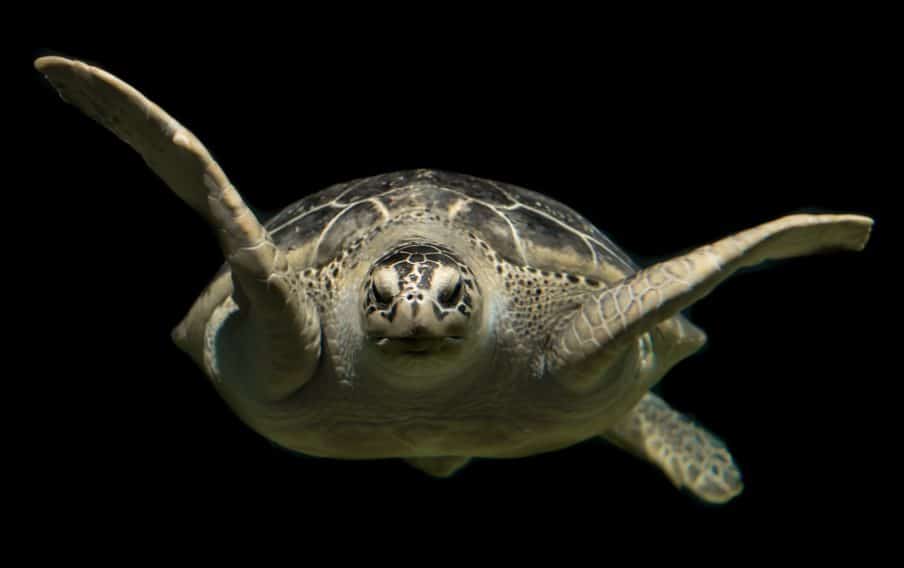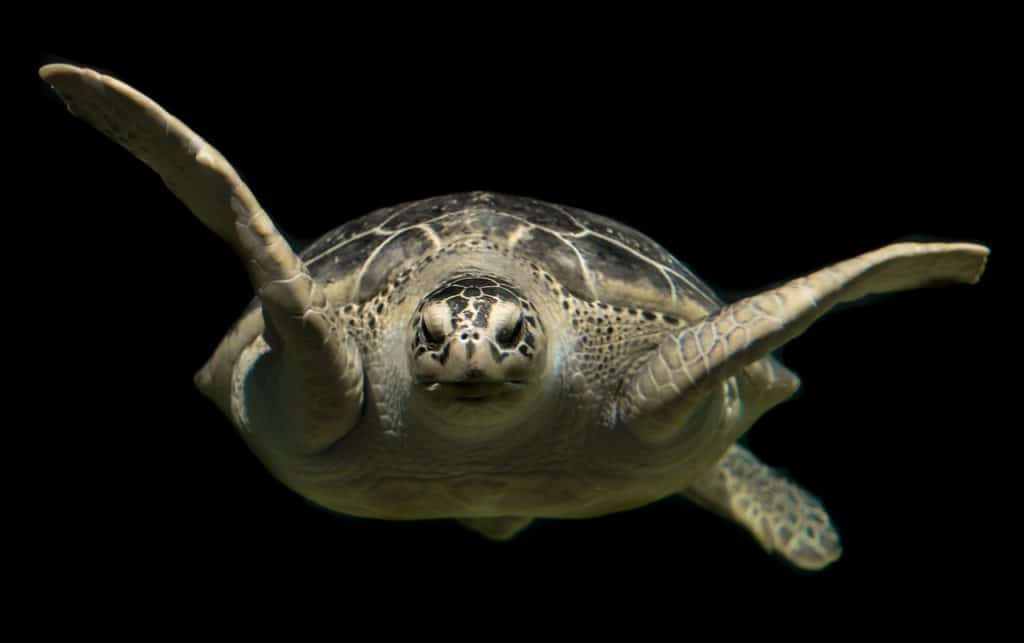
The best time of year to see turtles in Costa Rica depends on the species you are hoping to see. For Olive Ridley turtles, the peak nesting season is from June to December along the Pacific coast, and the best place to see them is Tortuguero National Park. For Leatherback turtles, the best time to see them is from February to April on the Pacific coast and from March to July on the Caribbean coast. The Hawksbill turtle can be seen from May to September on the Caribbean coast.
Costa Rica is one of the most biodiverse countries in the world and home to fascinating wildlife including five main species of Turtles: Leatherback, Green, Olive Ridley, Hawksbill and Loggerhead.
If you’ve got your timing right and know the best places to go, you’ll be able to witness the unforgettable sight of turtles hatching and embarking on their first journey to the sea.
With dozens of nesting beaches, it’s a true sea turtle paradise and Costa Rica is one of the best places in the world to spot these charming creatures.
The 5 Species of Turtles in Costa Rica
Costa Rica is home to five species of sea turtles: leatherbacks, green sea turtles, olive ridleys, hawksbills, and loggerhead turtles. All of these species are endangered. The population of Costa Rican sea turtles has declined by 90% in the last few decades.
1. Leatherback Sea Turtles
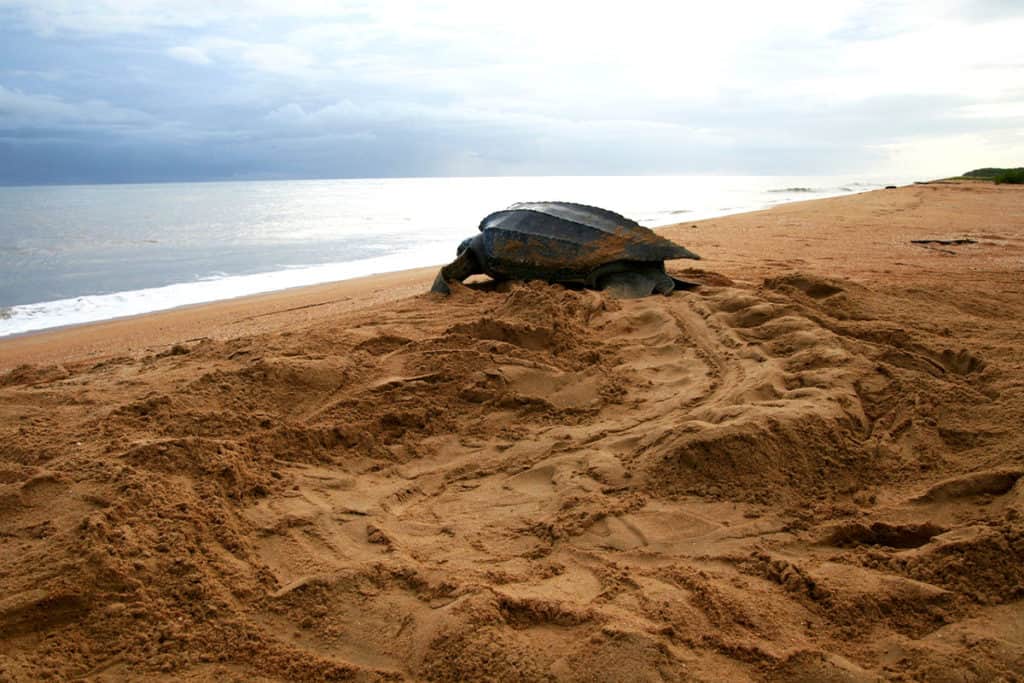
The leatherback is the largest living marine turtle. It can reach a length of 6 feet and weigh up to 2,000 pounds. Unlike most turtles, the leatherback lacks a distinctive hard shell.
Instead, its carapace is covered with a leather-like combination of flesh and oily skin. Leatherback turtles are usually found in the open ocean where they pursue their prey down to the depths of 3,000 feet. These marine giants feed almost entirely on jellyfish.
Where to See
Las Baulas National Marine Park—named for the leatherback turtles or las baulas—in Playa Grande on the Pacific coast is the prime leatherback turtle nesting and hatching site in Costa Rica. With an estimated 800 leatherback turtles visiting every year, this is the second-largest turtle nesting location in the world.
The Tortuguero National Park and the Gandoca-Manzanillo Wildlife Refuge on the Caribbean coast host leatherback turtles during the months when they are not nesting on the Pacific side.
Hatching Season
On the Caribbean shores, leatherback turtles flock to the beaches to lay eggs between March and May, whereas hatching season spans from April to September.
On the Pacific coast, the period from September to March is the prime nesting time for leatherbacks. You can catch a glimpse of turtles hatching from January to May.
2. Green Sea Turtles
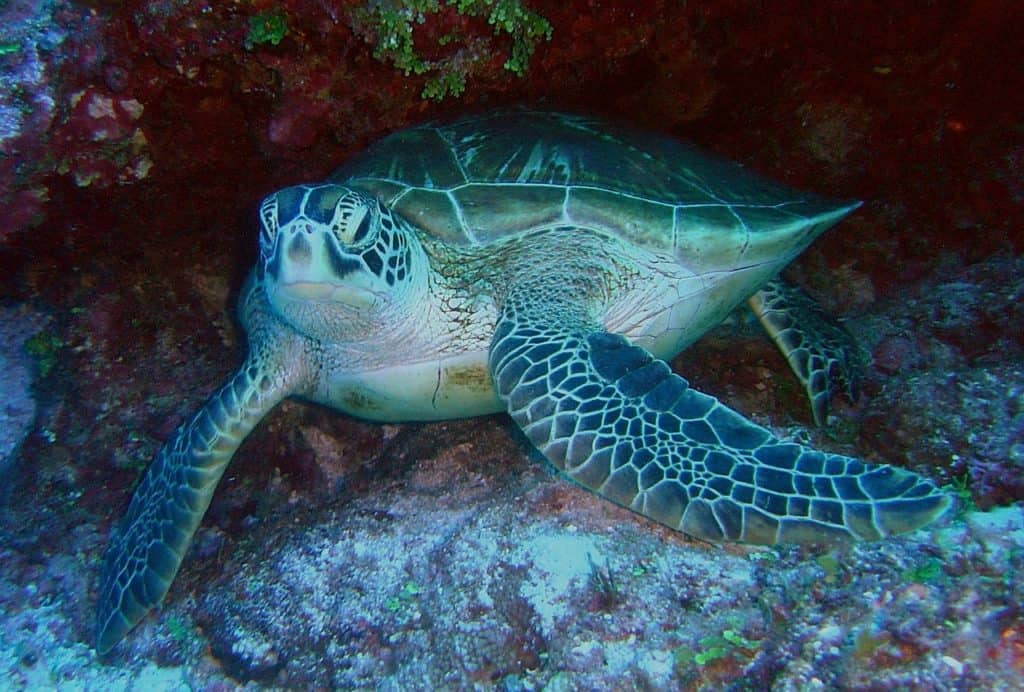
Although smaller than the leatherback, the green sea turtle is still a massive creature that can grow to 5 feet and weigh up to 500 pounds. Its name refers to the color of its skin and not carapace which is generally either grey, brown, or black.
Unlike leatherbacks, green sea turtles inhabit shallow lagoons, feeding mostly on various species of seagrass. This is one of the rare sea turtle species to leave the water when it’s not nesting and bask in the sun.
Where to See
Green sea turtles are known to gather in large numbers on the Caribbean beaches of Costa Rica. Tortuguero National Park on the northern Caribbean coast is one of the most important green sea turtle nesting sites in the world.
Hatching Season
The peak nesting season for these famous Costa Rican shelled residents is June through October. If you visit Costa Rica between July and December, you’ll have good chances to spot green sea turtle hatchlings making their great escape to the sea.
3. Olive Ridleys Sea Turtles
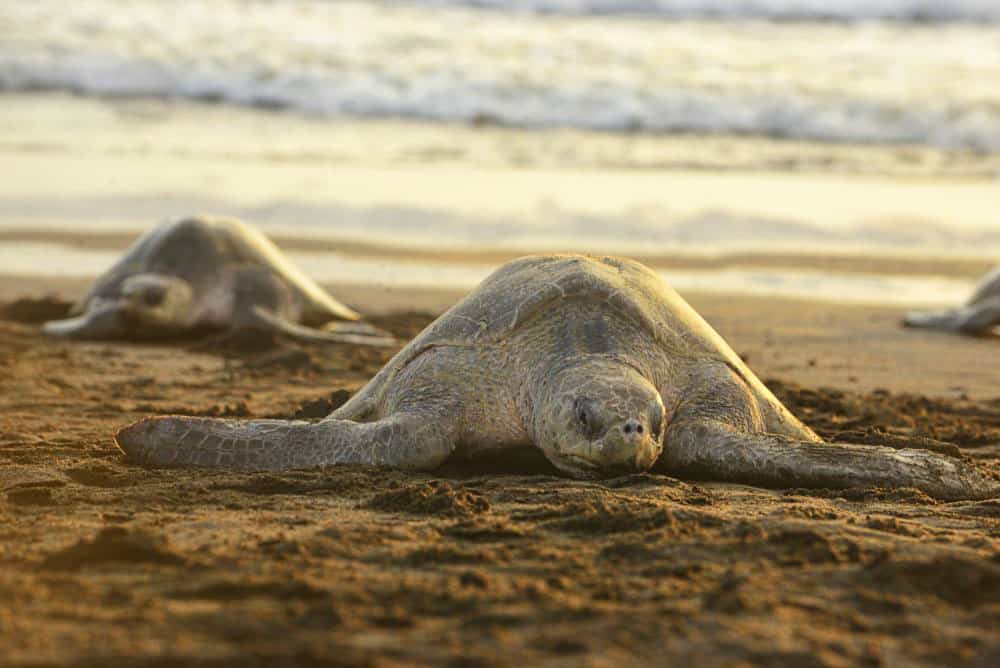
The olive ridley, also known as Pacific ridley, is one of the most abundant sea turtle species on the planet. These turtles are typically around 2 feet long and can weigh anywhere from 75 to 100 pounds. The olive ridley lives in the open ocean. It is mostly carnivorous, feeding on jellyfish, snails, crabs, and shrimp.
Olive ridleys are known for their annual mass nesting events called arribadas. Arribadas usually occur around the new moon and may involve as many as 20,000 turtles nesting on the beach in a single night. Costa Rica is one of the few locations in the world where this unique phenomenon takes place.
Where to See
Ostional Wildlife Refuge and Santa Rosa National Park on the Pacific coast are the prime nesting and hatching spots for Costa Rica’s olive ridley population. To watch spectacular displays of arribadas, head to Playa Ostional, Playa Samara, or Playa Nancite.
Hatching Season
Olive ridleys lay their eggs throughout the year along the Pacific coast, but on most beaches nesting spans from July to November.
October through January is the ideal time to watch olive ridleys set forth on their journey to the ocean. They will continue to hatch for several more months, although usually on a smaller scale.
4. Hawksbills Sea Turtles
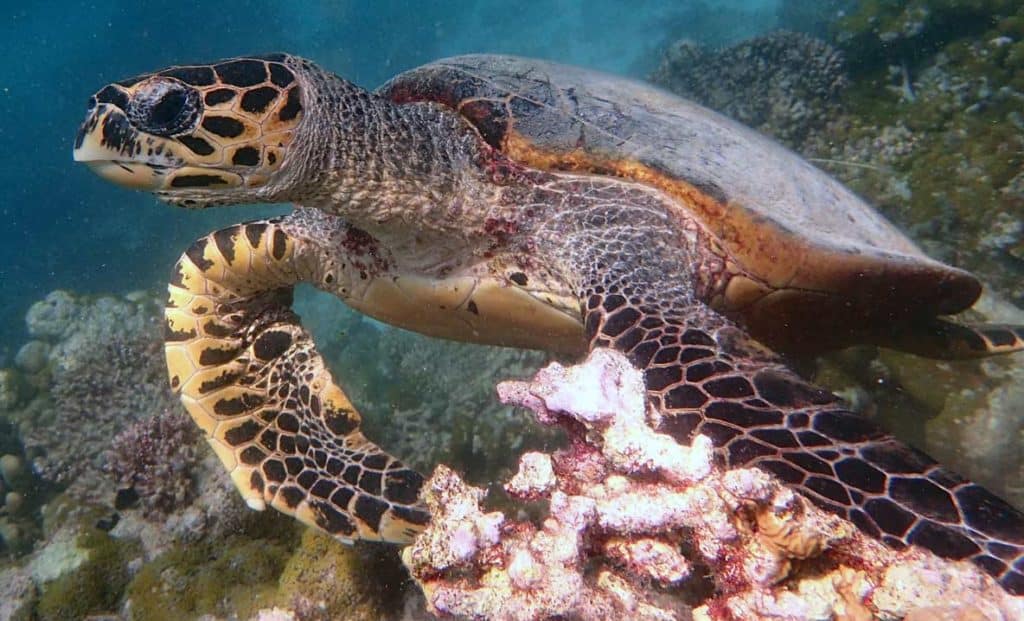
The hawksbill’s name comes from its hooked bill similar to a hawk’s beak. These are medium-sized turtles, around 3 feet long and weighing 100-150 pounds. Hawksbills avoid deep waters and are found mainly on coastlines where they feed on sea sponges.
Hawksbills are famous for their exquisite shells in colors ranging from dark to golden brown with streaks of orange, red, and black. Due to the high demand for tortoiseshell jewelry and decor, their populations have been significantly reduced and they are today critically endangered.
Where to See
Hawksbill marine turtles nest mostly on the Caribbean beaches of Costa Rica. They are commonly seen in Tortuguero National Park, although they can also be spotted in the waters off Golfo Dulce on the South Pacific coast, in the Cahuita National Park, and Gandoca-Manzanillo Wildlife Refuge.
Hatching Season
The best time to admire these beloved seaside visitors as they are nesting and hatching is between March and October.
5. Loggerhead Sea Turtles
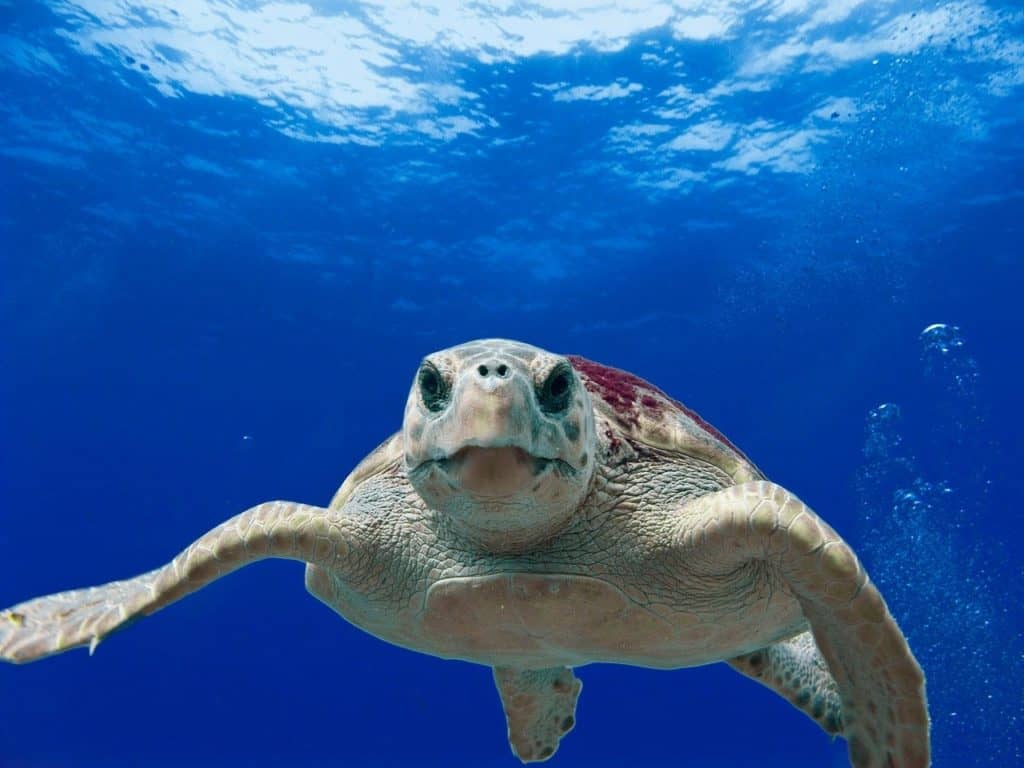
The loggerhead sea turtle, named for its remarkably large head, is the world’s biggest hard-shelled turtle. It often measures over 3 feet and can weigh up to 440 pounds. Loggerheads have very strong jaws that allow them to eat hard-shelled sea creatures including clams, crabs, mussels, and sea urchins.
Where to See
Tortuguero National Park and Barra de Pacuare on the Caribbean coast are the go-to destinations to see loggerhead sea turtles hatching.
Hatching Season
Costa Rican Caribbean beaches host hatchlings between the months of May and August.
Turtle Watching Tips
Witnessing dozens of tiny turtles climbing up through the sand and scrambling to reach the water is an unforgettable experience. However, you should always make sure to respect the rules for safe turtle viewing.
- Don’t use lights of any kind, including camera flashes. Hatchlings follow the light horizon over the sea and the white wave crests to orient themselves. Any other light sources can confuse them and lead them in the wrong direction.
- Don’t approach sea turtles and don’t block their access to the sea. Make sure to stay at least 35 feet away at all times.
- Don’t make sudden movements and remain quiet when observing turtle hatching. For most sea turtle species, undisturbed nests guarantee more than 90% chances of a successful hatch, while nests disturbed by humans or animals tend to have less than 25% success rate.
- Most of the turtle nesting and hatching sites in Costa Rica are only accessible through authorized access points. Many beaches including Tortuguero and Ostional are closed after 6 pm to protect the turtles and their nests and avoid disturbing the hatching process. After this, only guided tours are allowed access.
- Hiring a guide is highly recommended for the best experience of observing sea turtle hatching. In addition, Costa Rican conservation efforts depend on generating income from organized viewings that replace illegal egg and meat harvests.
How Do Sea Turtles Hatch?
Sea turtles lay their round soft-shelled eggs, using hind flippers to dig a foot or two deep holes in the warm sand. The sand temperature in the nest will determine the hatchlings’ gender. If it is lower than 81°F, turtles will be male, while at temperatures over 86°F they will all be female. Anything in between results in a mix of male and female hatchlings.
After burying the eggs, the female returns to the sea and young turtles are left to survive on their own. It takes around two months until they are ready to hatch.
Turtle hatchlings use a special tooth called a caruncle to break open the eggshell. Once free from the egg, they remain in the nest for several days before they start digging their way to the surface. Sea turtles are born with an embryonic egg sac which provides them with enough nutrition for those first few days until they can find food.
The newly hatched turtles remain near the sand surface until nighttime when the temperatures are cooler and they are less likely to overheat or fall prey to birds, snakes, and crabs. When they are ready, sea turtles hatch in unison. They create movements reminiscent of a pot of boiling water, known as “turtle boils”, as they make a frenzied rush to the sea.
The tiny turtles find their way by following the downward slope of the beach and the reflections of the moon and stars on the water. After entering the sea, hatchlings are usually not seen for several years. Because not much is known of their whereabouts, this period is known as the “lost years”.

